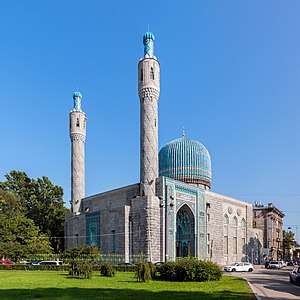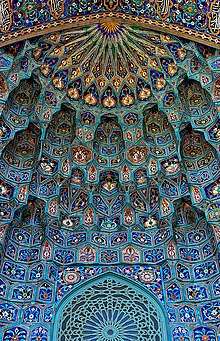Saint Petersburg Mosque
The Saint Petersburg Mosque (Russian: Санкт-Петербу́ргская мече́ть), when opened in 1913, was the largest mosque in Europe outside Turkey, its minarets 49 meters in height and the dome is 39 meters high. The mosque is situated in downtown St Petersburg. It can accommodate up to five thousand worshippers.[1]
| Saint Petersburg Mosque | |
|---|---|
 | |
| Religion | |
| Affiliation | Islam |
| Status | Active |
| Location | |
| Location | St. Petersburg, Russia |
| Architecture | |
| Architect(s) | Nikolai Vasilyev |
| Type | Mosque |
| Completed | 1921 |
| Specifications | |
| Capacity | 5,000 |
| Dome(s) | 1 |
| Dome height (outer) | 39 meters |
| Minaret(s) | 2 |
| Minaret height | 49 meters |
The founding stone was laid in 1910 to commemorate the 25th anniversary of the reign of Abdul Ahat Khan in Bukhara. By that time, the Muslim community of the Russian then-capital exceeded 8,000 people. The projected structure was capable of accommodating most of them. The architect Nikolai Vasilyev patterned the mosque after Gur-e-Amir, the tomb of Tamerlane in Samarkand. Its construction was completed by 1921.
Worshippers are separated by gender during a worship service; females worship on the first floor, while the males worship on the ground floor. The Mosque was closed to worshippers from 1940 to 1956.
History
In 1882, Selim-Girei Tevkelev who in 1865 was appointed the Mufti of Orenburg turned to and obtained agreement from minister Count Tolstoy with the requirement for a mosque in St. Petersburg.[2] In 1906, the Minister formed a special committee headed by Ahun Ataulla Bayazitov to collect 750,000 rubles within 10 years for the construction of the mosque. They organised collections in towns and providences of Russia and received donations from many sponsors.[2] In addition the committee input securities in total amount of 142,000 rubles and also stamps for mosque's project. The biggest donor was Said Abdoul Ahad, Emir of Bochara who undertook all expenses for the building.

The location of the mosque was symbolic, sited opposite the Peter and Paul Fortress, in the city centre. The permission to purchase the site was given by Emperor Nicholas II in Peterhof on 3 July 1907. That autumn, the committee approved the project by architect Nikolai Vasilyev, the engineer Stepan Krichinsky, and construction was overseen by academic Alexander von Hohen. The building facade was made by combining both oriental ornaments and turquoise blue mosaic.
On 3 February 1910, the foundation stone-laying ceremony was performed by Ahun Bayazitov, attended by government, religious and social figures. Among those who attended were Mohammed Alim Khan, the ambassadors of Ottoman Empire and Persia, and Tevkelev, the leader of the Muslims party in the Duma .
The walls were made with grey granite and the dome and both minarets (tower) are covered with mosaic ceramics of sky-light-blue colour. These were created by Peter Vaulin in his workshop in Kikerino.[3] Skilled craftsmen from Central Asia took part working on the mosque. The facades are decorated with verses from Koran using the characteristic Arabian calligraphy. Internal columns are made from green marble. Women pray on the first floor, above the western part of the hall. The mosque was covered by huge special made carpets woven by the Central Asian craftsmen.
In 1940, Soviet authorities banned services and turned the building into a medical equipment storehouse. At the request of the first Indonesian President, Sukarno, ten days after his visit to the city, the mosque was returned to the Muslim religious community of St. Petersburg in 1956.[2] A major restoration of the mosque was carried out in 1980.
See also
References
- RBTH, Darya Gonzalez, for (6 November 2013). "Top 7 most amazing and beautiful mosques in Russia".
- Saint Petersburg mosque in "Russian Mosques" Archived 2011-07-15 at the Wayback Machine (English translation), accessed October 2011
- "Mosque". www.encspb.ru. ROSSPEN. Retrieved 24 December 2018.
External links
| Wikimedia Commons has media related to Saint Petersburg Mosque. |

.jpg)



